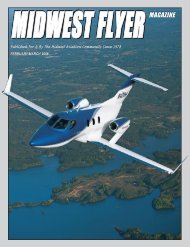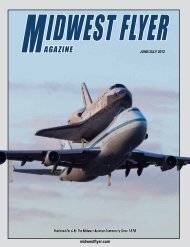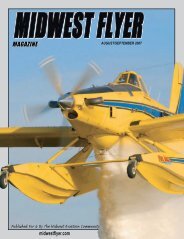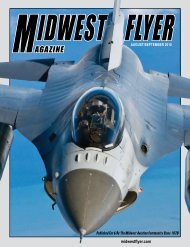Create successful ePaper yourself
Turn your PDF publications into a flip-book with our unique Google optimized e-Paper software.
At Our AirportsThe Ulteig team is busy collecting information about the pavementcondition at 67 of North Dakota’s paved public airports. The resultswill be delivered in an online database airports can use to manageupcoming pavement projects.When airfield pavement testing first began, it was adestructive and disruptive process, often severely interruptingoperations with the labor-intensive requirements, according tothe article. By the middle of the decade, nondestructive testsemerged, though completing them and properly analyzing thedata still required significant amounts of time.The current PCI procedure was actually developed inthe early 1980s as a visual evaluation used to assess thecondition of airfield pavement, according to a 2001 articleabout the pavement condition index. The PCI procedure iscommonly used because it has received widespread acceptancethroughout the world, creating consistent understandingabout pavement conditions among the world’s airports. Thescale used for the PCI ranges from 0-100, and the index isused by a variety of agencies to designate the condition ofpavement.Changing The Delivery MethodAirports in North Dakota have used the PCI procedureto evaluate pavement conditions since the 1980s, Wannersaid. The final product has always been a static report that isprinted or provided on a disc. When Ulteig and its partnersAviation Fueling Equipment“Service After The Sale”✓ Design, Installation, Service ✓ Fueling Dispensers✓ 24-Hour Fueling System ✓ Above & Below Ground Tanks✓ Proprietary & Bank Card SystemsEmail: sales@mnpetro.comPhone: 763-780-5191Toll-Free: 888-797-7677682 39th Avenue NE • Columbia Heights, MN 5542134 OCTOBER/NOVEMBER 2012 MIDWEST FLYER MAGAZINEdecided to propose on the project, they knew they wanted todo something different.“We heard from a lot of managers that the studies in thepast didn’t get looked at after the initial delivery,” Nelsonsaid. “Often only one copy was provided to an airport, andsometimes a manager might put it in their office and neveropen it again or the report would go to a consultant so theairport wouldn’t even have access to it.”To address this issue, Ulteig, Applied PavementTechnology, and EVS determined that an online databasewould better suit the changing needs of North Dakotaairports. That means the results of the study will be accessibleto any airport managers, pilots or other individuals whorequire it.“We are excited to put this useful toolin the hands of airport managers acrossthe state,” said Jon Scraper, vice presidentof aviation at Ulteig.A bonus of having the informationso accessible means it will be easierfor airport managers to present theinformation to airport authorities, airportboards, or communities when discussingthe need for future projects, Wanner said.“The hope is that airports will beable to take a larger role in planning for the future of theirairport by being provided a pavement management systemthat is easy to use and understand,” he explained. “I believethe selection committee felt that Ulteig and its partnerswould revolutionize the study and provide a deliverable thatwould be able to take more of a lead role in airport planningthroughout the state.”Having the information in an online database also meanskeeping the pavement conditions up-to-date will be easier.When a North Dakota airport plans a repair or replacement,current information from the project can be easily inputted inthe PCI database. This allows these airports to develop betterstrategies for maximizing the money spent on an airport’slargest investment: pavement. Being able to manage fundingto properly maintain that investment for the longest period oftime is the best use of precious dollars, Scraper said. “Makingthe information easy to access and utilize means airportscan budget for projects at the right time, which would savefederal, state, and local airport project dollars,” Wannerexplained.Addressing Changing Traffic VolumeJon ScraperIt’s no secret that western North Dakota is seeingunprecedented growth thanks to the oil boom. That growthis also affecting airports in the region that are dealing withincreased flight traffic. The four commercial service airportsin western North Dakota –Williston, Minot, Bismarck,and Dickinson – have all experienced an increase in trafficassociated with the boom. Minot International Airport isMN Petroleum Ad July2012.indd 17/16/12 5:40 PM
















